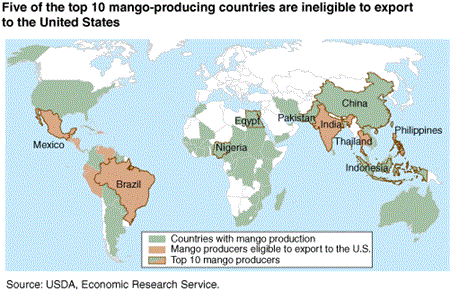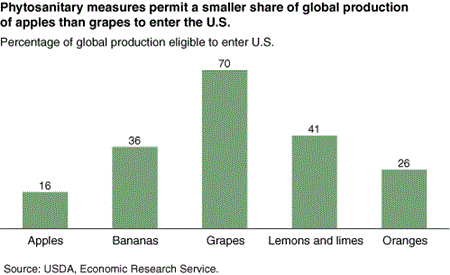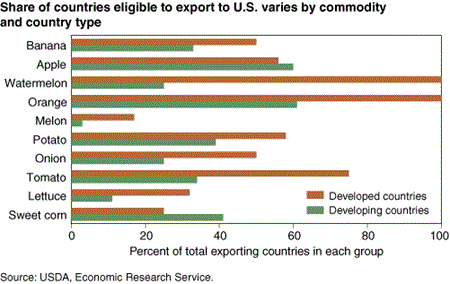Data Feature
Phytosanitary Regulations Shape Fruit and Vegetable Trade Patterns
Increased trade helps meet U.S. consumers’ growing demand for a variety of fresh fruit and vegetables throughout the year. ERS calculates that the import share of domestic consumption of fruit and nuts has grown over the past 25 years from 10 to 35 percent for fruit and nuts and from 5 to 15 percent for vegetables. To reduce the risk of inadvertent entry of pests and diseases that could harm agriculture, public health, or the environment, imports of these products are regulated by USDA’s Animal and Plant Health Inspection Service (APHIS).
Phytosanitary Regulation of the Entry of Fresh Fruits and Vegetables into the United States, a data set on the ERS website, identifies the countries, under USDA phytosanitary rules, that are eligible to export fresh fruit and vegetables to the United States. The data set includes data on the absolute and relative importance of these countries in international production and trade, individually and overall. For example, the 19 countries eligible to export apples to the United States account for 17 percent of world apple production and 33 percent of exports.
The data set also includes the development status of export-eligible countries, along with the ranking of each commodity in U.S. production and disappearance (a proxy for consumption) data. For instance, 55 countries are eligible to export bananas to the United States, 48 of which are low- to middle-income nations. Bananas rank 23rd in U.S. fruit production and 1st in per capita availability. Having access to information on countries that are currently eligible to export fresh fruit and vegetables to the United States lays the foundation for better understanding of trade patterns and can underpin analyses of the market effects of potential changes in phytosanitary import rules.
Countries Must Petition To Gain Access to the U.S. Market
Agricultural products are imported into the United States only after successfully completing USDA’s approval process. After a country petitions USDA to allow importation of a specific commodity, APHIS conducts a risk assessment to identify the economic and environmental damage pests associated with the commodity might cause if the pests were to enter the United States. No import is risk free, but APHIS may recommend that the commodity be allowed to enter if certain steps are followed to reduce pest risk to acceptable levels. In these cases, APHIS works with the exporting country to develop a plan outlining the procedures and treatments required as a condition of commodity entry into the United States.
A recent example of a country that completed this process is India, which received authorization to export fresh mangoes to the United States. The APHIS risk assessment examined the potential economic and environmental impact of 20 pests associated with mangoes from India. APHIS concluded that irradiating mangoes could reduce the risks to negligible levels, so India is now one of the 17 countries eligible to export this fruit to the United States. Five of the world’s top 10 mango producers, including China, are not yet eligible to export to the United States.
Phytosanitary Measures Can Have Economic Effects on U.S. Markets and Consumers
Phytosanitary measures such as import bans can restrict the seasonal availability of a product or raise costs for consumers. Advances in science and technology are helping APHIS design less trade-restrictive measures that reduce phytosanitary risks of the imports demanded by consumers. Lifting a ban on a country’s exports to the United States may lower prices for U.S. consumers, cause changes in ex-porters’ shares of the U.S. market, or both. The magnitude of changes may be greater in cases where entry of a commodity is more highly restricted. Of the five most widely traded fruits, grape imports are the least restricted, and apples are the most restricted, as measured by the share of global production eligible to enter the United States.
The assessment requires data on U.S. domestic production of a commodity (if any), along with data on production in countries eligible to export to the U.S. This information helps analysts estimate whether the expected benefits from increased trade will be greater than the expected costs of potential yield decreases or the increases in production costs associated with the entry of a pest or disease. These economic analyses can be important in the evaluation of proposed changes in phytosanitary policy, such as lifting the longstanding ban of imports of Mexican avocados. APHIS estimated that eliminating geographical and seasonal restrictions on Mexican avocados while maintaining a number of other phytosanitary safeguards would lead to annual net benefits of $70 million to the United States. These estimates provide analytic support for the decision by USDA to replace its ban on imported Mexican avocados with a more targeted approach that allowed increased imports.
Phytosanitary Standards Limit Exports from Some Developing Countries
A number of developing countries face obstacles in complying with stringent phytosanitary standards, but many are successful. While all developed countries are eligible to export both onions and tomatoes to the United States, among developing countries, 61 percent are eligible to export onions and 25 percent are eligible to export tomatoes. The reason a country may not appear on a list of eligible countries could be that it has not petitioned for authorization after concluding that it could not compete in U.S. markets, rather than because of phytosanitary problems. Other countries do have problems, either with pests, or a lack of technical capacity to address the pest issues. Various multilateral and national institutions are seeking to assist these countries in overcoming these obstacles.
Phytosanitary Regulation, by Peyton Ferrier, USDA, Economic Research Service, February 2021
New Phytosanitary Regulations Allow Higher Imports of Avocados, USDA, Economic Research Service, November 2006




